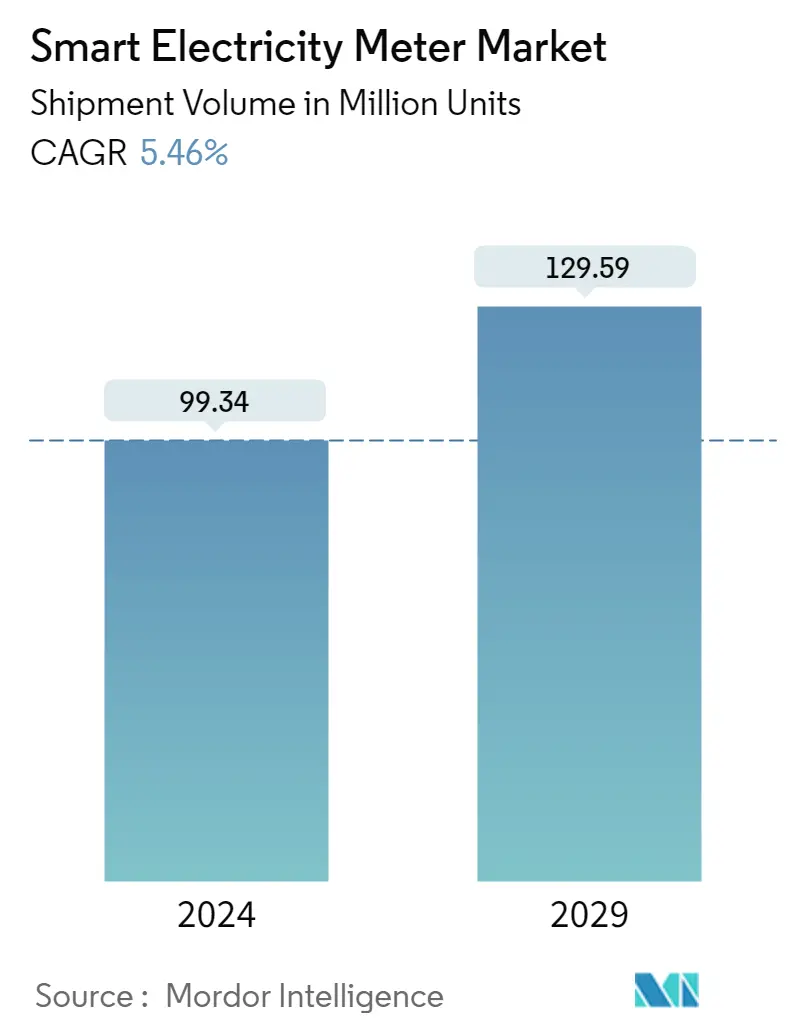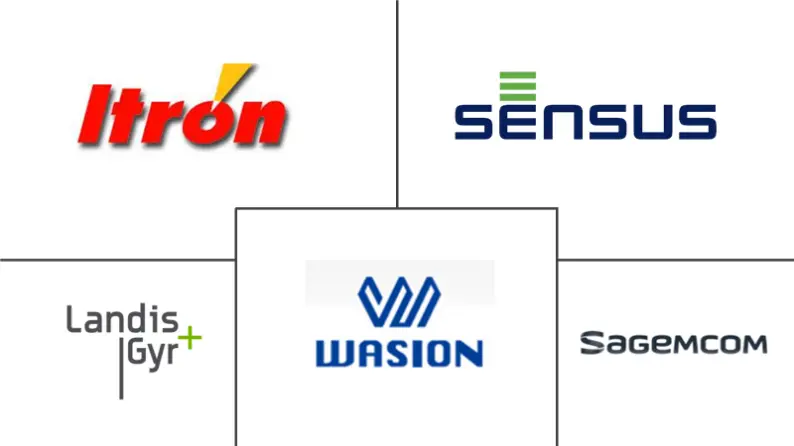Market Size of Smart Electricity Meter Industry

| Study Period | 2019 - 2029 |
| Market Volume (2024) | 99.34 Million units |
| Market Volume (2029) | 129.59 Million units |
| CAGR (2024 - 2029) | 5.46 % |
| Fastest Growing Market | Asia Pacific |
| Largest Market | North America |
| Market Concentration | Medium |
Major Players
*Disclaimer: Major Players sorted in no particular order |
Smart Electricity Meter Market Analysis
The Smart Electricity Meter Market size in terms of shipment volume is expected to grow from 99.34 Million units in 2024 to 129.59 Million units by 2029, at a CAGR of 5.46% during the forecast period (2024-2029).
Smart meters deployment enabled the implementation of a Home Energy Management System (HEMS) or Building Energy Management System (BEMS) that allows visualization of the electric power usage in individual homes or entire buildings.
- Energy efficiency is increasingly becoming the primary focus globally, owing to the increasing economic activities, which led to high energy consumption rates and pushed global electricity grids to their limits. The global electricity generation in 2021 stood at 28,466 Terawatt-hours, according to BP.
- Digitization has been further accelerating and modernizing energy efficiency measures due to which the deployment of smart grids has been increasing globally, as they are capable of dynamically optimizing supply and fostering supply of large amounts of electricity from renewable energy sources, such as solar power.
- The recent COVID -19 outbreak and nationwide lockdown across the globe impacted the overall rollout of Smart meters globally. The global COVID -19 pandemic resulted in lockdowns in various parts of the world, which halted several operations across industries. As a result, the shipments and installations of smart meters were also affected.
- However, as the COVID-19 regulations are slowly being eased, the number of smart meters being installed is also expected to witness an increase in the long term. In many developed regions, most energy suppliers have been motivating their customers to upgrade to smart meters as it minimizes direct human interaction and offers several other benefits across the entire value chain, such as incentivizing energy conservation and facilitating easy bill payments, remote meter reading, improving billing and collection efficiency, reducing aggregate technical and commercial losses, and curbing power theft, among others.
- Consumer electronics, office equipment, and other plug loads consume nearly 15% to 20% of the total residential and commercial electricity while not in the primary mode. Most of this energy is consumed when they operate in low-power modes (even while they are not in use). Consumers are increasingly tending to install a smart energy management system to track such scenarios.
Smart Electricity Meter Industry Segmentation
Smart metering solutions comprise meters or modules with communication capabilities (either one-way or two-way) embedded within the meter or attached to the meter. They are used to collect and store data from the meters, which can be transmitted to handheld computers, mobile units, telephones, cellular, power line carriers, etc. The meter data can be used to optimize the operations by analyzing the stored interval data.
Smart Electricity Meter Market is segmented by End-user (Commercial, Residential, and Industrial), and Geography. The market sizes and forecasts are provided in terms of value (USD) for all the above segments.
| By End-user | |
| Residential | |
| Commercial | |
| Industrial |
| By Geography | |||||||||||
| |||||||||||
| |||||||||||
| |||||||||||
| |||||||||||
|
Smart Electricity Meter Market Size Summary
The smart power meter market is poised for significant growth, driven by the increasing focus on energy efficiency and the integration of renewable energy sources. Smart meters facilitate the implementation of Home and Building Energy Management Systems, allowing for detailed visualization and management of energy consumption. The global push towards digitization and smart grids is enhancing the ability to optimize energy supply dynamically, which is crucial as electricity demand continues to rise. The market is also recovering from the disruptions caused by the COVID-19 pandemic, with a resurgence in installations as restrictions ease. Developed regions are particularly active in promoting smart meter adoption, highlighting benefits such as reduced human interaction, improved billing efficiency, and enhanced energy conservation.
In the residential sector, smart electricity meters are becoming essential as they measure and communicate energy usage to central utility systems, supporting efforts to reduce CO2 emissions and optimize energy consumption. The market is bolstered by increasing residential construction, government mandates, and the growing trend of urbanization, which encourages the adoption of smart home technologies. In the United States, the market is leveraging advanced metering infrastructure to enhance grid monitoring and integrate distributed energy resources. The competitive landscape is characterized by strategic innovations and collaborations among major players, with significant investments in smart meter projects globally, including initiatives in India and Germany.
Smart Electricity Meter Market Size - Table of Contents
-
1. MARKET INSIGHTS
-
1.1 Market Overview
-
1.2 Industry Value Chain Analysis
-
1.3 Industry Attractiveness - Porter's Five Forces Analysis
-
1.3.1 Threat of New Entrants
-
1.3.2 Bargaining Power of Buyers
-
1.3.3 Bargaining Power of Suppliers
-
1.3.4 Threat of Substitute Products
-
1.3.5 Intensity of Competitive Rivalry
-
-
1.4 Assessment of the Impact of COVID-19 on the Industry
-
-
2. MARKET SEGMENTATION
-
2.1 By End-user
-
2.1.1 Residential
-
2.1.2 Commercial
-
2.1.3 Industrial
-
-
2.2 By Geography
-
2.2.1 North America
-
2.2.1.1 United States
-
2.2.1.2 Canada
-
-
2.2.2 Europe
-
2.2.2.1 United Kingdom
-
2.2.2.2 Spain
-
2.2.2.3 Germany
-
2.2.2.4 Italy
-
2.2.2.5 France
-
2.2.2.6 Turkey
-
2.2.2.7 Nordics
-
2.2.2.8 Benelux
-
2.2.2.9 Rest of Europe
-
-
2.2.3 Asia-Pacific
-
2.2.3.1 China
-
2.2.3.2 India
-
2.2.3.3 Japan
-
2.2.3.4 Australia and New Zealand
-
2.2.3.5 South Korea
-
2.2.3.6 Southeast Asia (Malaysia, Singapore, Thailand and Others)
-
2.2.3.7 Rest of Asia-Pacific
-
-
2.2.4 Latin America
-
2.2.4.1 Brazil
-
2.2.4.2 Mexico
-
2.2.4.3 Columbia
-
2.2.4.4 Chile
-
2.2.4.5 Rest of Latin America
-
-
2.2.5 Middle East & Africa
-
2.2.5.1 GCC
-
2.2.5.2 South Africa
-
2.2.5.3 Egypt
-
2.2.5.4 Rest of Africa
-
2.2.5.5 Rest of Middle East
-
-
-
Smart Electricity Meter Market Size FAQs
How big is the Smart Electricity Meter Market?
The Smart Electricity Meter Market size is expected to reach 99.34 million units in 2024 and grow at a CAGR of 5.46% to reach 129.59 million units by 2029.
What is the current Smart Electricity Meter Market size?
In 2024, the Smart Electricity Meter Market size is expected to reach 99.34 million units.

